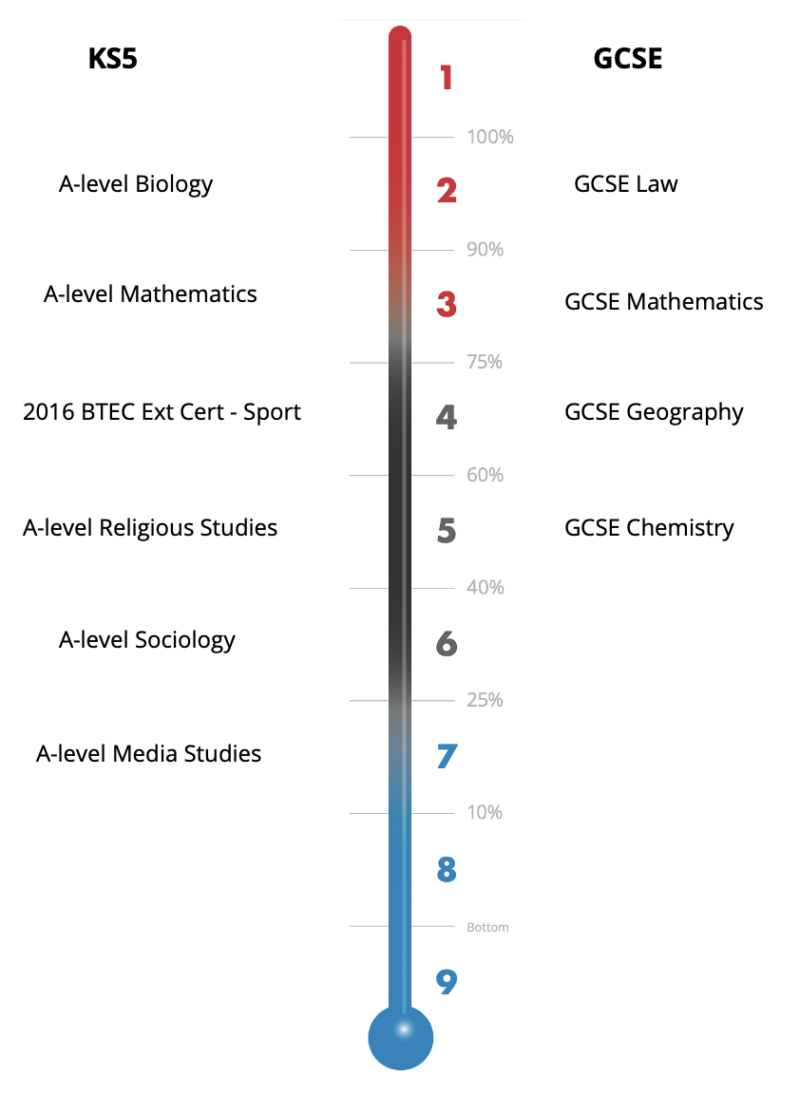Using Alps Connect to Set Aspirational Targets
Blog written by John Roe.
At Alps we believe that developing an aspirational culture within schools and colleges is a key driver for great outcomes. Setting targets for students and staff that are both aspirational and realistic provides a clear direction for success and helps everyone to reach their full potential. In this blog, I discuss my experiences of using Alps Connect to support target setting and the development of an aspirational, ‘can do’ culture.
1. Generating Minimum Expected Grades (MEGs)
As a post-16 leader, I had high expectations for all my students and wanted to support them as fully as possible to help them reach their full potential. Alps uses national datasets to generate Minimum Expected Grades (MEGs) that reflect progress made by students in the top 25% of schools and colleges. Staff and students at my sixth form found the concept of Alps MEGs easy to understand and were motivated by the challenge of working towards outcomes that matched the top 25% of providers nationally.
We devoted time at the start of year 12 through tutor periods, assemblies and information evenings to explain the Alps system in detail to both students and parents. Even though Alps Connect generates students’ MEGs automatically when prior attainment data is uploaded, we encouraged our students to calculate their own average GCSE point scores and then to use these to determine their MEGs. We wanted students to fully understand how their targets had been derived and this simple exercise helped us to achieve this.
It is important to stress that MEGs are just starting points and they should not be considered as a ceiling when target setting. To motivate and empower our students we would explain to them that each year, many of our students exceeded these challenging targets through hard work, dedication and focus.
2. Setting personalised targets
 The MEG is an average across subjects, and it is important that teachers understand that students nationally make stronger progress in some subjects than others. The Alps score for subject thermometers is calculated using a formula which compares expected points with actual points across the student entries. Each subject has their own unique Alps thermometer, and the Alps score you need to match providers in the 75th percentile is different across subjects. An Alps score of 1.00 means that students on average have achieved their MEG and it is important that teachers understand where that score would rank them on their unique subject thermometer. For many subjects achieving an Alps score of 1.00 would rank providers in the top 25% or better in our dataset, however for some subjects where students make stronger progress nationally an Alps score of 1.00 would rank much lower on the thermometer.
The MEG is an average across subjects, and it is important that teachers understand that students nationally make stronger progress in some subjects than others. The Alps score for subject thermometers is calculated using a formula which compares expected points with actual points across the student entries. Each subject has their own unique Alps thermometer, and the Alps score you need to match providers in the 75th percentile is different across subjects. An Alps score of 1.00 means that students on average have achieved their MEG and it is important that teachers understand where that score would rank them on their unique subject thermometer. For many subjects achieving an Alps score of 1.00 would rank providers in the top 25% or better in our dataset, however for some subjects where students make stronger progress nationally an Alps score of 1.00 would rank much lower on the thermometer.
The above diagram (based on the 2019 DfE national benchmark) shows where an Alps score of 1.00 ranks different subjects on their specific Alps thermometers. In media studies, achieving an Alps score of 1.00 would result in an Alps grade much lower down the thermometer than A-level subjects such as biology and mathematics. This is because students nationally make stronger progress in this subject. Therefore, it is important to consider setting personalised subject targets for students to ensure that each subject performs at the required level on their subject thermometer.
Alps Connect has the option of allowing providers to set personalised targets, which students can be tracked against in the Student Analysis Overview. This gives schools and colleges further flexibility when it comes to target setting, allowing them the option of either using MEGs directly or as a framework for setting personalised targets for students that are even more aspirational. For example, students in biology might have personalised targets that are in line with the Alps MEG, whereas students in media studies may have personalised targets that are one above this grade.
When working as a post-16 leader, I found it particularly useful to upload a monitoring gradepoint at the start of the academic year which was based on the MEGs. This enabled subject leaders and teachers to see what Alps grade would be achieved if students on average achieved these target grades. By using the ‘How do I’ tool within the subject area of Connect, it was possible to determine how many students would need to exceed the MEGs for the subject to be ranked in the top 25%. Staff were then able to use this information in conjunction with their own knowledge of the students’ ability and potential to support the target setting process. Alongside this, they also found it useful to model the impact of raising student targets on value-added outcomes using the ‘What if’ tool.
Many subject leads would also be inclined to raise targets above the MEG if value-added outcomes already matched the top 25% of the dataset and they wanted to add further challenge. Involving students in the target setting process can also be beneficial and many schools that I have worked with have found that getting students to set their own targets with subject teachers using the MEG as a starting point can lead to them feeling more ownership over their grades and to higher levels of motivation.
One of my favourite features in Alps Connect is the option within the MEG reports section to download individual student postcards listing each students’ subjects and target grades. I found it useful to print these off for students at the start of the academic year and to use them in tutor periods to encourage reflection. Students would write down their feelings about each target grade and during the year we would ask them during form tutor interviews to reflect on the progress they were making in relation to these.
3. Self-evaluation and improvement planning
Robust, evidence-based self-evaluation is fundamental to any improvement cycle. Using Alps Connect for results analysis in August and September allows senior leaders to review the progress that has been made against strategic priorities from the previous academic year and supports the establishment of new priorities for the upcoming year. When reviewing examination results it is important that senior and middle leaders consider the following questions:
- What priorities have emerged in terms of subjects and student groups?
- Were there any results / VA outcomes that came as a shock?
- How do strategic indicators compare with predictions from in-year monitoring?
- How accurate were predicted grades during the year and is any training required?
- Were outcomes consistent across different teaching sets?
- Is Performance Measures data in line with predictions? How does it compare to previous years?
- Were intervention sessions targeting the appropriate students?
- Do improvement plans need amending because of these results?
Using Alps Connect effectively to analyse results at a cohort, subject and student level supports senior leaders when making judgements on whether the curriculum is meeting the needs of all learners. It also allows senior and middle leaders to identify strengths and good practice which can be shared across departments as well as improvement priorities that need to be addressed during the upcoming academic year.
At my sixth form, subject review meetings organised early in the autumn term provided excellent opportunities for senior and subject leaders to discuss the analysis and to agree improvement targets where appropriate. Additional review meetings during the academic year could then be used to evaluate progress towards these targets and to determine intervention priorities if necessary. Within the subject analysis area in Connect, it is easy to identify subjects that have strong value-added outcomes and where outcomes have been consistently strong over several years. It is also easy to identify subjects where outcomes have improved or declined as well as subjects where more focus and targeted support is needed.
By using the Subject Analysis and Student Analysis Overview areas in Connect, it is possible to explore whether students have made similar progress in all subjects and by using the comparison tools you are able to focus on the progress of student groups as well as individual students. From my experience of using Alps Connect, I would recommend that staff leading Alps within a school or college work in close partnership with data-managers to ensure that the information uploaded is accurate, and that the data contains key information such as students’ gender, ethnicity, SEND, disadvantaged/non-disadvantaged status etc. Uploading this information will allow users to make maximum use of the platform’s comparison tools and to be able to compare the value-added performance of these key student groups. Including information such as teaching sets and tutor groups in any upload will also enhance the quality of the analysis and allow leaders to identify whether there is variation or consistency in value-added performance. This again can support target setting at a strategic, cohort and departmental level.
I hope you have found this blog useful and for further tips on analysis and target setting, remember to book your place on one of our upcoming ‘Hitting the Ground Running’ series of Alps Champions webinars.

About John Roe:
John has worked in education for 22 years as a science teacher, head of department and pastoral lead. John is passionate about creating an aspirational culture and supporting students to achieve their full potential. Prior to joining Alps, John was Director of Radyr Sixth Form in Cardiff for 10 years, where he lead the transformation of the sixth form with student outcomes consistently matching the performance of the top 2% nationally.
Need more information?
If you would like any further information, please contact one of our expert advisers.


